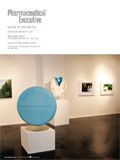Naming Your Brand
Choosing a name for a new pharmaceutical product used to be a pretty straightforward proposition. Twenty years ago, most drug names were descriptive or functional in nature; they relied on the indication, therapeutic category, or generic name for their creative direction.
Choosing a name for a new pharmaceutical product used to be a pretty straightforward proposition. Twenty years ago, most drug names were descriptive or functional in nature; they relied on the indication, therapeutic category, or generic name for their creative direction.

Clayton Tolley
The primary goal of descriptive names was to create an identity that would send a clear message to healthcare professionals—the ones who needed to remember the name and write the prescription.
Descriptive names often relied upon scientific or Latin-based terms familiar to most physicians. So, Spectracef, an oral antibiotic, took its cue from the generic cefditoren and the antibiotic classes cephalosporins and cephamycins. It used familiar word parts, which helped first-time hearers more easily understand, accept, and adopt the new name.
A NEW EAR TO TURN
When drug companies started advertising directly to consumers in 1997, names needed to speak not just to doctors and pharmacists, but also to patients and their families or caregivers. Consumers started taking on a bigger role and asking for certain brands, and names based on familiar medical terminology weren't so familiar anymore. Consumers usually don't know generic names; they just know they want to feel better. A new opportunity emerged to communicate benefits directly to consumers by way of more emotional and aspirational names.
WHAT'S IN A NAME?
Names like Sanctura, Boniva, and Alvesco spring from entirely different creative strategies and involve an attempt to convey an emotional benefit or a promising message. Sanctura, created for the treatment of overactive bladder, borrows from the word sanctuary in order to convey a feeling of security and comfort. Boniva, which is used to manage osteoporosis, combines the words bone and viva to suggest the idea of long life. Alvesco, indicated for asthma, is created from the concept of alfresco, to make one think of open air.
In some cases, the name may not represent any tangible benefit. Instead, it may attempt to communicate a tone or feeling the pharma company wants to embody in the brand. Zyvox, for instance, doesn't have any inherent meaning, but the tone suggest strength, an important quality for an antibiotic.
A MOB OF NAMES
A practical reason for the shift away from purely descriptive names is the shrinking number of legally available choices. Approximately 400,000 brands are registered and protected in Class 5 of the US Patent and Trademark Office. This is partly because of the exponential growth of the industry, but also because each player is taking up more trademark territory.

Most popular names
Medium-size and small firms have joined big pharma companies in applying for trademark protection for their next big idea.
Trademarking names in Phase II and early Phase III can help some smaller companies differentiate and build awareness, but it means one less name available, even though the product may never leave the lab.
Larger companies claim even more trademark space because of the number of products in their pipelines and their financial ability to register for many more names than they plan to use immediately.
The strategy is to have a bank of available names should a first-choice name get rejected by the regulatory agencies. Gaining regulatory approval of names is becoming more difficult due to the potential for medication errors as a result of sound-alike and look-alike qualities.
NOT REAL ENOUGH
Regulatory agencies have also begun rejecting more names because they feel the names are too fanciful or make a claim that clinical data cannot support.
Given dwindling options and restrictions, how can your team ensure they are selecting a name that will differentiate your product—and get approved? Consider then these steps:
Identify your primary and secondary target audiences early in the process. A name can only communicate one idea (or maybe two), so it is paramount to focus on the most compelling message to your particular target.
Develop a creative strategy that takes into account the most important attributes you want to convey.
- Understand the different types of names and evaluate how each could benefit your product.
- Explore different types of names at the beginning of the process.
- Refine your creative direction until one name becomes the team favorite.
- Be cognizant of the legal screening processes. Most legal teams will review a short list of names, but they won't do full legal searches until you've selected your top name candidates.
- Make sure your team (including someone from legal) agrees on a tailored review schedule that meets the desired deadline, while maximizing the allocated budget.
- Conduct a global linguistics evaluation. Professional translators and native speakers can offer feedback on pronunciation, associations, cultural, or slang references, and similarity to local products.
- Market research and a medical-advisory-panel review can further narrow a list of name candidates as well as provide valuable support material.
- Experiment with unique sounds and letter combinations.
- Keep an open mind.
When a final and preferred name with several backup candidates is agreed on, you'll be ready with the data to support your brand in the regulatory review.
Clayton Tolley is president of Addison Whitney, an inVentiv Health company. He can be reached at cdtolley@addisonwhitney.com
The Misinformation Maze: Navigating Public Health in the Digital Age
March 11th 2025Jennifer Butler, chief commercial officer of Pleio, discusses misinformation's threat to public health, where patients are turning for trustworthy health information, the industry's pivot to peer-to-patient strategies to educate patients, and more.
Navigating Distrust: Pharma in the Age of Social Media
February 18th 2025Ian Baer, Founder and CEO of Sooth, discusses how the growing distrust in social media will impact industry marketing strategies and the relationships between pharmaceutical companies and the patients they aim to serve. He also explains dark social, how to combat misinformation, closing the trust gap, and more.
